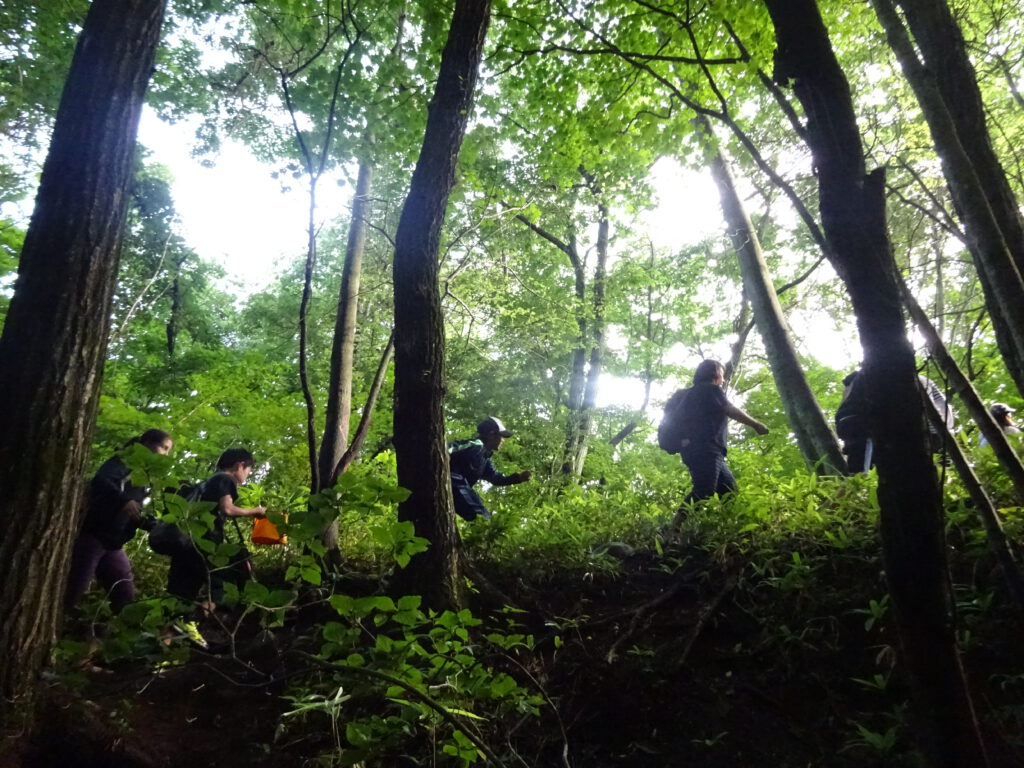Elicia Cousins, doctoral student in Sociology at Northeastern University.
Spearheaded by individuals, citizen groups and NGOs across the country, hoyō seek to allow children and families to spend time away from the contaminated areas where they still live.
Featured image: Hiking through a lush summer forest in Kiyosato, Yamanashi Prefecture. Photo credit: Elicia Cousins
Mornings during school vacation are a busy time at the Fukushima City train station. The platforms and bus loading areas bustle with children heading off to various destinations throughout the country for short-term retreats, widely known as hoyō, that primarily focus on outdoor activities and immersion in nature. Such evacuation retreats have been going on since the months following the Fukushima Daiichi nuclear disaster of March 11th, 2011. Spearheaded by individuals, citizen groups and NGOs across the country, hoyō seek to allow children and families to spend time away from the contaminated areas where they still live. I had the opportunity to volunteer for two such retreats during the summer of 2012, and have done so ever since. This past summer I continued my work as a volunteer and organizer with the additional role and lens of a researcher; I visited one of the most well-established retreat sites (Kumi No Sato, described below) and interviewed ten other retreat leaders and staff members in order to explore the various methods of implementation of hoyō, and their goals with regard to physical, mental, and social health and well being for participants.
Residents are not eligible for governmental support or compensation should they wish to evacuate, and evacuees are increasingly pressured to return.
After the nuclear accident, the maximum allowable limit for radiation exposure in Fukushima prefecture was quietly raised to an alarming 20 mSv/year, far above the 1 mSv/year limit for the rest of Japan. To put this in context, a 1991 law developed to protect victims of Chernobyl mandates evacuation from any areas exceeding 5mSv/year, and anyone living in areas between 1mSv–5mSv/year has the right to government support for evacuation and for specialized health care. While the Japanese Nuclear Accident Child Victim’s Law of 2012 outlined similar plans for financial and medical support, it remains largely toothless and unimplemented. In any case, several cities that lie well outside of the government-designated evacuation zone, including Fukushima, Date, Koriyama, and Iwaki, not to mention several areas outside of Fukushima prefecture, remain hotspots of radiation contamination yet are still labeled “safe.” Residents are not eligible for governmental support or compensation should they wish to evacuate, and evacuees are increasingly pressured to return.
Government campaigns instead assert that radiation is “not a big deal,” and that worrying about radiation is more harmful to one’s health than radiation itself.
As of February 2016, the number of confirmed or suspected thyroid cancer cases totaled 166 among roughly 380,000 children under 18 being surveyed by the Fukushima prefectural government. Despite the fact that the Japanese National Cancer Center estimates that thyroid cancer in the late teen-age bracket is only found in 0.9 out of every 100,000 individuals, the Japanese government denies that radiation exposure could be a potential cause of greater incidence. Government campaigns instead assert that radiation is “not a big deal,” and that worrying about radiation is more harmful to one’s health than radiation itself. Such power dynamics and the denial of causal influence are recurring themes in the history of understanding the human health impacts of low-dose radiation exposure; this terrain of scientific and public knowledge remains highly contested despite extensive literature on adverse health outcomes of victims of the Hiroshima and Nagasaki bombings and the 1986 Chernobyl disaster, nuclear industry workers, and of populations living near normally operating nuclear power plants.
As featured in Hitomi Kamanaka’s 2015 documentary “Little Voices from Fukushima,” post-Chernobyl communities in Belarus and Ukraine have been sending children away on yearly 3-week evacuation retreats for decades, with hard-won funding support from their governments. Any child who has any level of exposure to radiation contamination is eligible to receive this support, including children who were born after the accident at Chernobyl. In Japan, however, the official narrative dictates with increasing compulsion that radiation is not an issue—logic that leads to the conclusion that evacuation retreats are not necessary, and thus not worthy of substantive government support. A meager, highly restrictive government grant does exist, but it is designed to support environmental education and nature immersion for children of Fukushima—surely not refuge from radiation exposure. In accessing such grants, retreat organizers are forced to adopt this depoliticized language, steering away from explicitly stating the underlying rationale. Many simply choose not to deal with the burdensome paperwork and red tape, relying instead on non-governmental grants and crowdfunding.
One of the most well-known retreat programs in Japan is run by the non-profit organization Okinawa Kumi No Sato, nestled on the site of a former pottery studio on the lush island of Kumejima, about a four-hour ferry ride from Naha City, Okinawa. Established in 2012 by the renowned investigative photojournalist Ryuichi Hirokawa, the program hosts 10 to 14-day retreats all year round and has welcomed over 2,700 children and mothers to date. Hirokawa is the editor-in-chief of the monthly magazine Days Japan, and was deeply involved in setting up the Hope 21 recuperation center in Belarus in 1994 for child victims of Chernobyl.
Such opportunities to openly talk about health concerns are rare, if not nonexistent, for most mothers living in Fukushima, as such topics are largely treated as taboo; many mothers find themselves surrounded by family and community members who shun anyone who raises their voice about radiation, health, and food safety.
Kumi No Sato is unique in that it offers comprehensive thyroid examinations. Mothers are informed of their own and their children’s results on the spot, but when children attend without a guardian, the results are sent directly to the parents. After all examinations happen, the visiting doctor holds an informal meeting with participating mothers to answer any questions they may have. Such opportunities to openly talk about health concerns are rare, if not nonexistent, for most mothers living in Fukushima, as such topics are largely treated as taboo; many mothers find themselves surrounded by family and community members who shun anyone who raises their voice about radiation, health, and food safety. Individuals who are outspoken about such issues may be labeled as disruptive and paranoid, spreading harmful rumors or fūhyōhigai (referring to the sales decline of produce from affected areas, spurred by radiation contamination concerns). As Dr. Aya Kimura argues in Radiation Brain Moms and Citizen Scientists (2016), the discourse of fūhyōhigai is highly gendered, and has largely been used to depict concerned women—especially those who avoid food from affected areas and pursue other exposure reduction strategies—as unpatriotic, confused, and irrational.
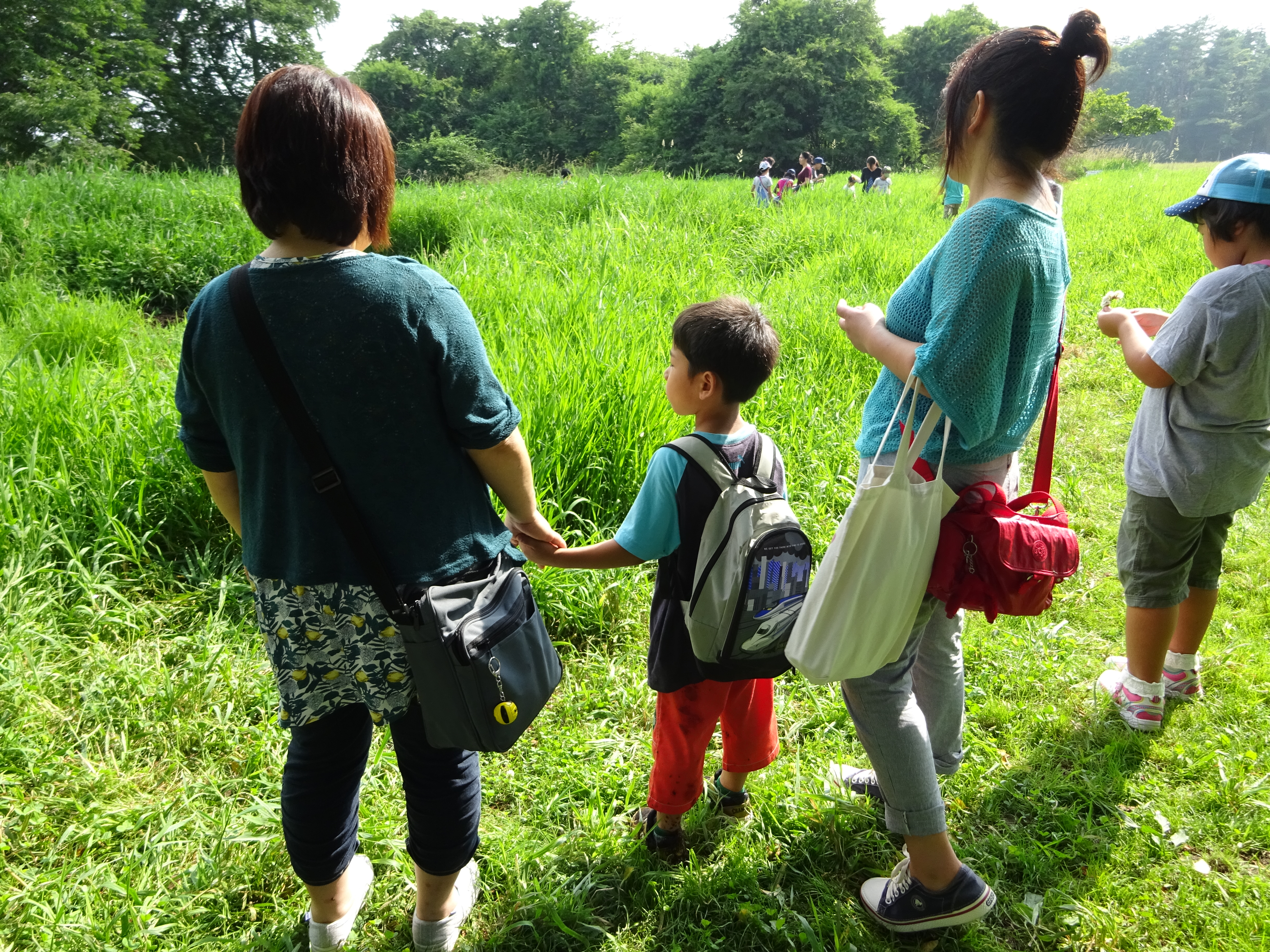
Two mothers and their children take a break from grasshopper-catching. Photo credit: Elicia Cousins.
In such a climate, it is no wonder that many mothers with young children feel isolated and highly stressed, and struggle to access information about radiation and health, methods of reducing exposure, or the range of available retreat programs. Some retreat leaders have even told me that some mothers attend retreats in secrecy for fear of being judged by community or family members; these individuals ask not to be photographed in any material that appears on retreat blogs or other social media platforms. I’ll never forget when one mother explained to me that her neighbor once knocked on her door after she returned from a retreat program with her two children, questioning where she’d been and why.
What they all share is the compulsion to somehow mobilize against the silent yet egregious injustices continuing to confront residents of highly contaminated areas.
Those who are involved in leading these retreats come from a wide range of backgrounds. I’ve met and/or worked with a traditional Okinawan musician and singer, a motorcycle gang member-turned-disaster relief activist, protesters against military bases in Okinawa, a former Tokyo salary-man, a long-time anti-nuclear activist who hosted Chernobyl-affected children…and the list goes on. Though some have a past of anti-nuclear or related activism and volunteer activity, others admit to having felt rather disengaged from societal issues before the nuclear accident. What they all share is the compulsion to somehow mobilize against the silent yet egregious injustices continuing to confront residents of highly contaminated areas. While there is no cohesive national network of such leaders, several smaller networks exist on the local or regional level.
I believe it’s reasonable to conclude that retreat organizers are well aware that their work does little to address the underlying issue at hand—that at the end of the day, these children must go back to live in an environment that is potentially detrimental to their health. Having chaperoned many groups of children traveling to and from various retreat destinations, I am not unfamiliar with the sinking feeling of saying goodbye at Fukushima station. While some groups such as Friends of the Earth Japan simultaneously engage in activism directly targeting victim support policy, the vast majority of retreat organizers (many of whom take on such projects on top of full-time work and are volunteers) barely have the resources to plan and host more than one retreat a year
Physical Detox
But there is also hope in some tangible benefits. Retreat leaders often refer to three main goals they have for participants, the first being physical detox, or the chance for participants to reduce their overall body burden. Most retreat leaders recognize that at least three weeks is needed for any significant reductions to occur—this became common knowledge among retreat leaders who had hosted children from areas affected by Chernobyl—and yet most programs are less than ten days long. Thus, many hope that children attend as many retreats as possible throughout the year so as to equal at least 3 weeks in sum. Nevertheless, retreat staff members believe that by eating large amounts of fresh, nutritious, and uncontaminated food even for a few days at a time, participating children can strengthen their immune systems and resilience.
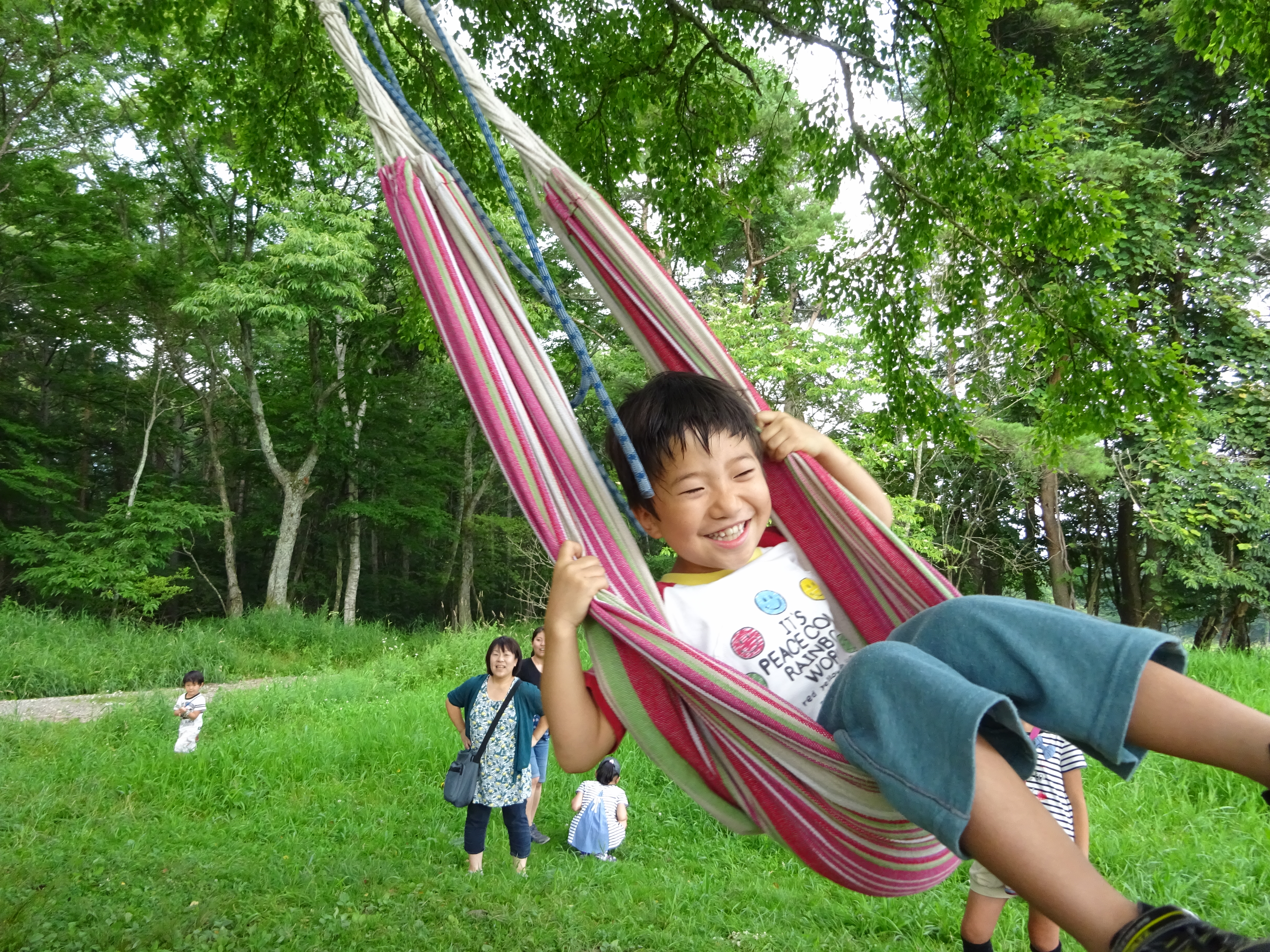
Soaring through the air on a makeshift swing by the forest. Photo credit: Elicia Cousins
Restorative Impact of Nature
Children may also benefit psychologically through the chance for unlimited playtime in outdoor environments like the ocean, rivers, forests, and outdoor playgrounds. The healing and health-promoting impacts of outdoor environments, including such benefits as stress reduction, attention restoration, and the evocation of positive emotions, have long been recognized in public health, environmental psychology, and geography scholarship.
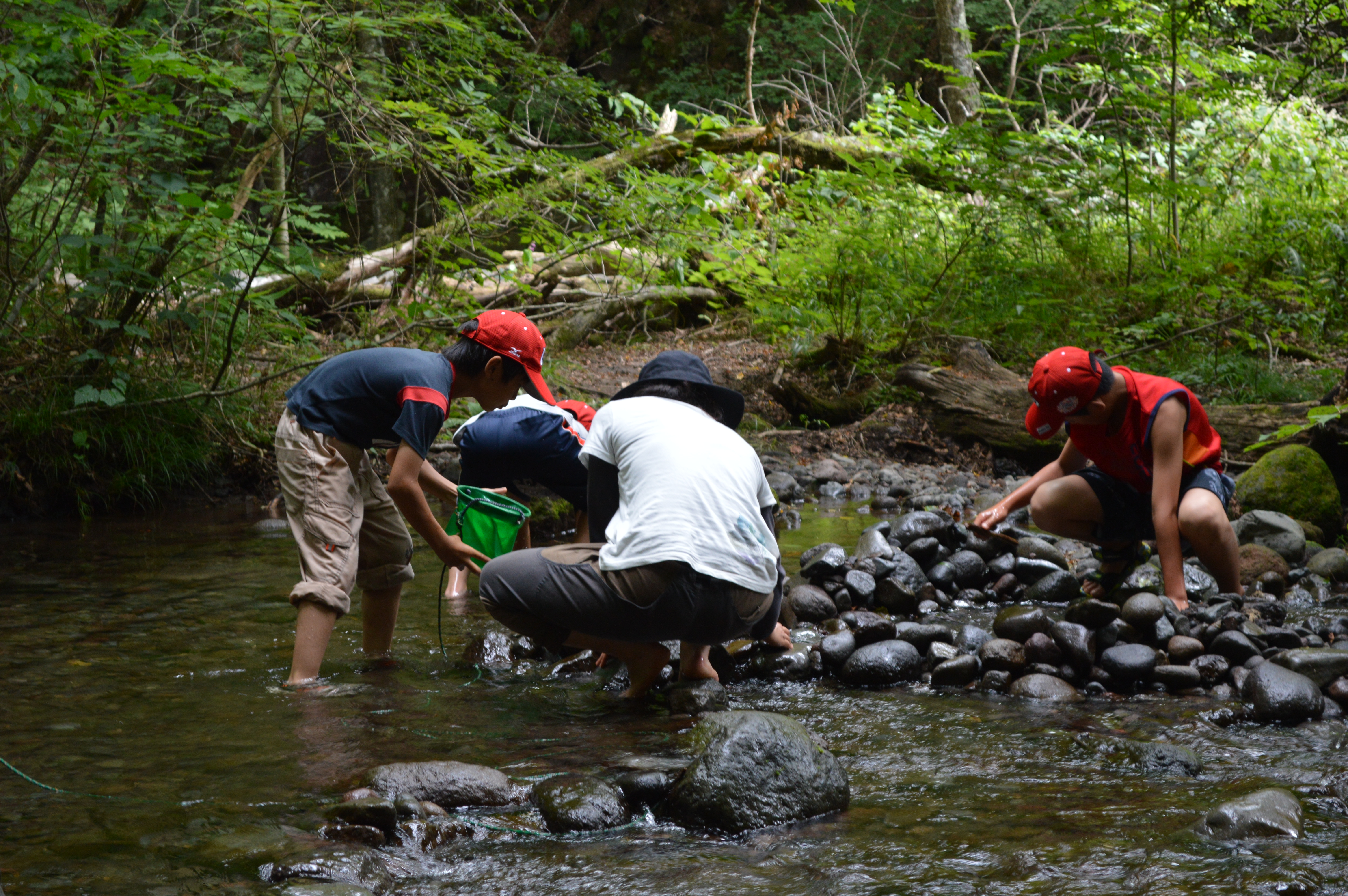
Discovering small creatures in the river. Photo credit: Elicia Cousins.
Increasing children’s exposure to nature is not only psychologically beneficial, but has often had the added effect of cultivating in them an appreciation for nature and interest in environmental issues.
Though most schools in Fukushima no longer restrict playing outside, concerned parents are understandably less willing to allow their children to play outside for prolonged periods of time. As one mother explained to me, “I’m not a nervous, uptight kind of mother—but parents in Fukushima feel that something mustn’t happen to their children as a result of this radiation—that they must protect their children… Children here seem to be fully absorbing the notion that they cannot play outside.” Many children have thus grown accustomed to staying inside and are not particularly interested in physical activity . Indeed, older children often insist on playing with their smartphone or eating junk food even during retreats, prompting some organizers to strictly prohibit even bringing such items.
Increasing children’s exposure to nature is not only psychologically beneficial, but has often had the added effect of cultivating in them an appreciation for nature and interest in environmental issues. During the retreat that I’ve led each year since 2013, for example, we always stay at an environmental education non-profit’s facility in Yamanashi prefecture and hike with the very knowledgeable rangers on staff.

A ranger points out animal tracks to a captive audience. Photo credit: Elicia Cousins.
I learned this past summer that one girl who has been attending this retreat since the beginning decided to join the environmental science club when she entered middle school last April. She shared with us that the opportunity to explore the nature of Kiyosato each summer had largely sparked her new interests. At the bi-annual retreat sponsored by Friends of the Earth Japan, which I have been volunteering for since its inception, topics including nuclear power and Fukushima, renewable energy, and sustainable lifestyles are routinely discussed with all participants. At this retreat, the goal is to inspire participants to later come back as volunteers, and to provide them with opportunities for leadership; two boys who first joined the project as 6th graders now participate as high school volunteer staff members. Some retreat programs that target older students in middle or high school offer significant opportunities for networking and leadership building alongside peers from other affected areas, and sometimes even peers and volunteers from other countries and cultural backgrounds.
Stress Relief and Social Networking
For some mothers, retreats offer the final nudge of inspiration and confidence to pick up and move with their children, even if it may lead to further financial instability, divorce, and leaving extended family behind.
The third broad goal has to do with stress relief and building social capital, particularly for participating adults. Mothers often describe the immense joy of seeing their children look so happy and energized, and the relief of not having to constantly say, “no, you can’t touch that,” or “no, you can’t play over there.” As one mother shared with me after the first retreat I led, “When my daughter and I were looking at photos from the trip after we returned to Fukushima, she turned to me and said: “Mommy, I was happy because you looked like you were having so much fun.’” As mentioned earlier, retreats also provide valuable opportunities for networking with like-minded mothers and highly sympathetic staff members and volunteers. Many stay in touch through Facebook and instant messaging, continuing to support each other, share frustrations, exchange useful information, or even share avenues to activism. For some mothers, retreats offer the final nudge of inspiration and confidence to pick up and move with their children, even if it may lead to further financial instability, divorce, and leaving extended family behind.
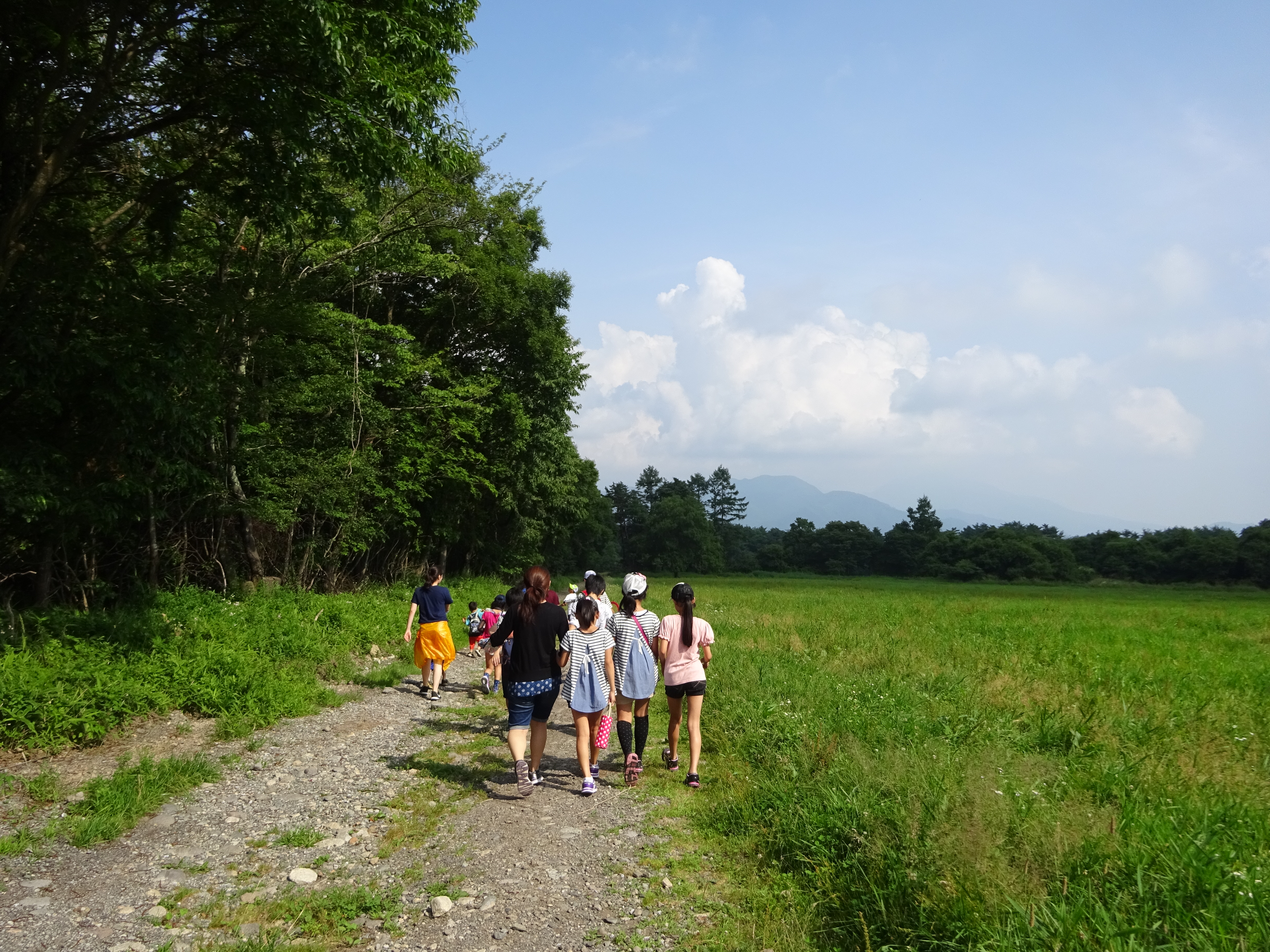
Exploring new outdoor playgrounds. Photo credit: Elicia Cousins.
While some have deliberately chosen to remain in Fukushima, many others have remained for lack of a feasible alternative, despite deep concerns regarding their children’s health.
The challenges ahead are many. Retreat leaders increasingly struggle with funding and having enough volunteers, and some face various pressures to stop engaging in projects that surreptitiously oppose government logic. It is not easy to take responsibility for the safety and wellbeing of large groups of young children, and meeting the needs and expectations of parents; burnout and feelings of discouragement are not uncommon. Leaders are further aware that their efforts do not reach all, and that many residents of Fukushima remain excluded from retreat opportunities due to various constraints: many retreats charge transportation and participation fees, and researching and applying for participation in retreats can demand a considerable amount of time and web literacy. Single mothers and dual-earner parents may be especially hard-pressed in devoting the time to researching retreats and in attending them with infants and preschool-aged children.
While some have deliberately chosen to remain in Fukushima, many others have remained for lack of a feasible alternative, despite deep concerns regarding their children’s health. Financial, work, and family constraints leave them with little choice, and government policies have all but abandoned them. Concerned residents—particularly young mothers—are continually in search of ways to find peace in their decision to stay and to minimize harm to their children in whatever way possible. Evacuation retreat leaders hope that they can provide temporary mobility, respite, and access to new social networks and opportunities. This is a story about how normal citizens have mobilized in the face of daunting, uncooperative power structures and invisible hazards—and it is one that is sure to continue for many years to come.

Five boys from Fukushima City gaze out to sea after a satisfying day of swimming and finding sea creatures. Minami-boso, Chiba Prefecture. Photo credit: Elicia Cousins.
Elicia Cousins is a doctoral student in sociology at Northeastern University, where she is also a member of the Social Science Environmental Health Research Institute (SSEHRI). She also collaborates with Silent Spring Institute, a non-profit dedicated to researching environmental chemical causes of women’s health issues, particularly breast cancer. Her current research addresses retailer and consumer-based campaigns to reduce emerging chemical exposure, as well as the ethical barriers to reporting individual biomonitoring and personal exposure results to study participants. Originally from Tokyo, Japan, Elicia continues to work with children still living in contaminated areas of Fukushima and other prefectures, and hopes to pursue further research in nuclear power and environmental justice.
References
Kamanaka, Hitomi. 2015. Little Voices of Fukushima. DVD. Tokyo, Japan: BunBun Films.
Kimura, Aya Hirata. 2016. Radiation Brain Moms and Citizen Scientists: The Gender Politics of Food Contamination after Fukushima. Durham, NC: Duke University Press.
McCurry, Justin. 2015. “Obesity rising among Fukushima children, survey shows.” The Guardian, January 27. Retrieved January 16, 2016.
Mitsuta, Kanna. 2015. “Factsheet: Pediatric thyroid cancer cases in Fukushima Prefecture. Out of the 137 cases of suspected or diagnosed with malignant thyroid cancers, 23 out of the 25 people who were retested had been told that they were clear of thyroid cancer in the first round screening.” Friends of the Earth Japan, September 4. Retrieved January 16, 2016.
